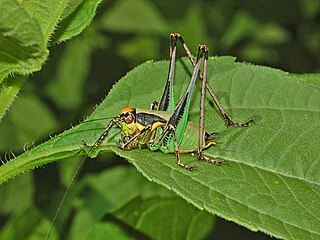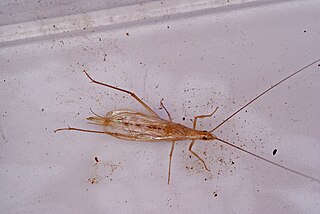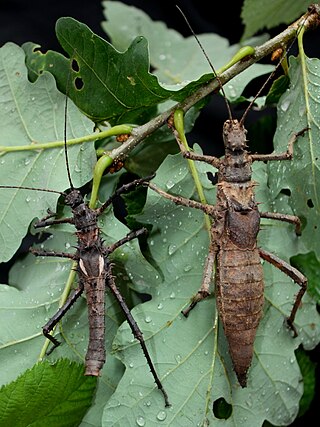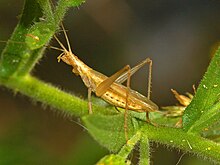
Insects in the family Tettigoniidae are commonly called katydids or bush crickets. They have previously been known as "long-horned grasshoppers". More than 8,000 species are known. Part of the suborder Ensifera, the Tettigoniidae are the only extant (living) family in the superfamily Tettigonioidea.

Gryllinae, or field crickets, are a subfamily of insects in the order Orthoptera and the family Gryllidae.

The speckled bush-cricket is a flightless species of bush-cricket belonging to the family Tettigoniidae. The species was originally described as Locusta punctatissima in 1792.

Tree crickets are insects of the order Orthoptera. These crickets are in the subfamily Oecanthinae of the family Gryllidae.

Tettigonia viridissima, the great green bush-cricket, is a large species of bush-cricket belonging to the subfamily Tettigoniinae.

Crickets are orthopteran insects which are related to bush crickets, and, more distantly, to grasshoppers. In older literature, such as Imms, "crickets" were placed at the family level, but contemporary authorities including Otte now place them in the superfamily Grylloidea. The word has been used in combination to describe more distantly related taxa in the suborder Ensifera, such as king crickets and mole crickets.

Xeris spectrum is a kind of horntail or wood wasp, that lives in coniferous forests. It is large wasp with a powerful ovipositor in females. Unlike other Siricid Wood wasps, Xeris spectrum does not have symbiotic fungi to aid its larvae as they burrow in the wood of fir and other conifer trees making it unique in the Siricidae. It is widespread and is found in large parts of Europe, Asia, Africa and North America.

Eupholidoptera chabrieri is a species of katydid belonging to the subfamily Tettigoniinae.

Tettigonia cantans is a species of bush crickets belonging to the family Tettigoniidae subfamily Tettigoniinae.

Omocestus viridulus, known in the British Isles as the common green grasshopper, is a Palearctic species of grasshopper in the subfamily Gomphocerinae.

Conocephalus fuscus, the long-winged conehead, is a member of the family Tettigoniidae, the bush-crickets and is distributed through much of Europe and temperate Asia. This bush-cricket is native to the British Isles where it may confused with the short-winged conehead. These two species are phenotypically similar; however, the distinguishing factor between the two is the fully developed set of wings the long-winged conehead possesses that allows for flight. In the short-winged coneheads the hind wings are shorter than the abdomen, causing the wings to be vestigial and the species is incapable of flight. For this reason it is hard to discriminate between the two species during the early stages of their life cycle before the wings have fully developed. The colouration of the conehead is typically a grass green with a distinctive brown stripe down its back, though there are some brown phenotypes.

Pholidoptera griseoaptera, the dark bush-cricket, is a flightless species of European bush-cricket; it is the type species of its genus with no subspecies.

Oecanthus fultoni, also known as the snowy tree cricket, or thermometer cricket, is a species of tree cricket from North America. It feeds on leaves but also damages fruit. The chirp of this species is often dubbed onto sound tracks of films and television shows to depict a quiet summer's night. The rate of chirp varies depending on the heat of the environment, allowing a listener to estimate the temperature.

Antaxius pedestris is a species of "bush crickets" belonging to the family Tettigoniidae. It was originally described by Johan Christian Fabricius under the scientific name of Locusta pedestris.

Neoitamus cyanurus, the common awl robberfly, is a species of 'robber fly' belonging to the family Asilidae.

Oecanthus dulcisonans is a species of cricket sparsely but widely distributed in the Mediterranean Basin and in the Middle East.

Haaniella dehaanii is a stick insect species. It is a typical representative of the subfamily Heteropteryginae. The occasionally used common name De Haan's haaniella refers to the species name.

Oecanthus capensis, the Cape thermometer cricket, is a species of tree cricket. It has been found that the rate at which these crickets chirp follows Dolbear's law.

Haaniella gintingi is a stick insect species from Sumatra. It is a typical representative of the subfamily Heteropteryginae. The occasionally used common name Ginting’s Haaniella refers to the species name.

Trachyaretaon negrosanon is a stick insect species from the family Heteropterygidae native to Negros.

























